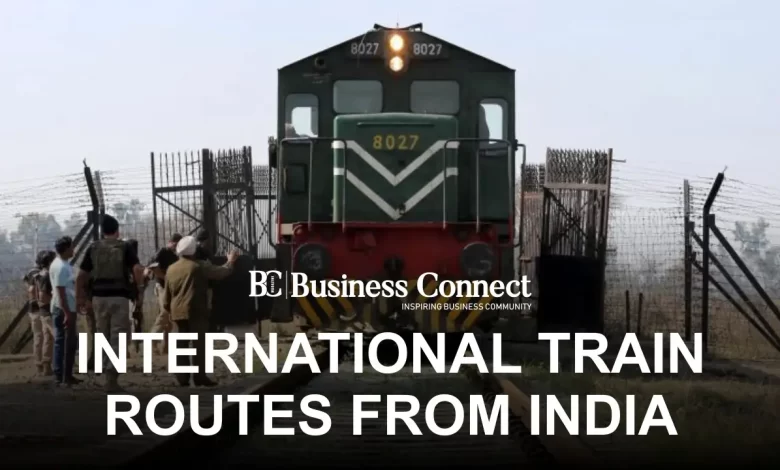International Train Routes From India

International Train Routes from India
The rail infrastructure in India is extensive. Recently, India has increased the number of neighbouring nations it has Indian railways routes with, including Pakistan, Bangladesh, and Nepal. Southern Bhutan will get a new train infrastructure thanks to plans by Indian Railways.
India is a land where you can find anything you need. From the cities to the villages, people live in an era of technology, community and education. People are always moving from state to state and then moving to other countries for a new life or maybe just a vacation. So, today we will look at the international train routes from India, which will help you make your next move easier.
Train Route between India and Pakistan.
In actuality, India and Pakistan had eight rail connections before the division (Part of India at that time). There are just two functioning train connections between India and Pakistan. The first one is the Samjhauta Express connecting Lahore, Pakistan, and Amritsar, India, located at Wagah. Superhit Bollywood movies like Veer Zaara and Bajrangi have brief glimpses of this train. In 2006, services on the second Thar Express train between Khokhrapar and Munabao (in Rajasthan, India) began (In Sindh, Pakistan).
Other rail connections are being considered for future deployment. These routes are Jammu-Sialkot, Ferozepur-Samosata, Ferozepur-Lahore, Amritsar-Lahore, and Amritsar-Sialkot.
Train:
The Samjhauta Express (transl. Friendship Express):
An international train from India is Samjhauta Express, also known as the Friendship Express, travels on Thursdays and Mondays between Delhi and Lahore in Pakistan and Attari in India. Samjhauta is a Hindi and Urdu term that signifies “agreement,” “accord,” and “compromise.”
Before the reopening of the Thar Express, this was the only train connection between the two countries. After the Simla Agreement, the train started running between Amritsar and Lahore, around 50.2 kilometres, on July 22, 1976. In response to turmoil in Punjab in the late 1980s, Indian Railways decided to halt operations at Attari, where customs and immigration clearances are handled. As part of an agreement between Indian Railways and Pakistan Railways, the distance was changed on April 14, 2000, to cover under three kilometres (PR).
Termini: Old Delhi, Lahore Junction.
Stops: Atari Shyam Singh and Wagah.
Distance travelled: 502 kilometres (312 mi).
average travel time: 11 hours, 42 minutes.
Thar Link Express:
The train’s number is 14890, and tickets may only be purchased for it offline upon receiving a valid Pakistan visa. From Balotra, Barmer, and Manabao, where it crosses the border into Pakistan, the train travels westward through a section of the Hyderabad-Khokhrapar Branch Line and Karachi-Peshawar Railway Line before beginning its voyage in India at the Bhagat Ki Kothi railway station in Jodhpur.
The journey, which departs from Bhagat Ki Kothi every Saturday at one in the morning and arrives in Munabao at seven in the morning, travels the indicated 381 kilometres in around 12 hours and 15 minutes. It passes through customs and crosses the border into Pakistan, arriving at Zero Point at 2.30 p.m. (local time in Pakistan) and getting to Karachi Cantonment at 2.15 p.m. (local time in Pakistan).
Termini: Bhalna, Thar Studio and Zero Point.
Stops: Zero Point and Bhagat Ki Kothi.
Distance travelled: 381 kilometres (239 mi).
average travel time: 12 hours, 15 minutes.
Train Route between India and Bangladesh:
When Bangladesh was established, many international train routes in India connecting Assam and Bengal changed their routes through the Siliguri Corridor. There are currently three rail connections connecting Bangladesh with India. The Bandhan Express, the primary passenger train line, travels weekly between Kolkata, India, and Dhaka, Bangladesh. Between Mahisasan (Mohishashon) and Shahbazpur, there is a second train. The third rail line connects Radhikapur and Birol. The Indian government has also sanctioned a rail connection between Akhaura, Bangladesh, and Agartala, India.
Bandhan Express:
A weekly fast rail service known as the Bandhan Express connects the Bangladeshi city of Khulna with the Indian metropolis of Kolkata. It is Bangladesh’s and India’s West Bengal state’s second brand-new, completely air-conditioned passenger rail connection. In English, the Bengali term Bandhan is translated as “bonding.” The Maitree Express II is how it was once referred to. Before purchasing a ticket for the Bandhan Express train, a valid passport and visa are necessary. Tickets are available at Chitpur Station in Kolkata, India, and Khulna Station in Bangladesh.
Since March 2020, the commercial operation of this train has been halted because of the COVID-19 epidemic. However, the train started running again on May 29, 2022.
Termini: Kolkata (KOAA)Khulna (KLNB).
Stops: 3
Distance travelled: 172 km (107 mi).
average travel time: 5 hours 20 mins.
Maitree Express train:
The Maitree Express train, pronounced Moitree Express, is the first contemporary, completely air-conditioned, international express train service from Kolkata in the Indian state of West Bengal to Dhaka in Bangladesh. Friendship Express is the English translation of the Bengali name Maitree Express, which indicates the significance of the train service to the cordial international ties between India and Bangladesh. Before British divided India, there were rail connections between the two nations;
The Maitree Express established this link between Dhaka and Kolkata in 2008 after having been shuttered for 43 years. The Bandhan Express, a second train service replicating the former Barisal Express train route, was launched in 2017 and ran between Kolkata and Khulna in Bangladesh.
Termini: Kolkata (KOAA) Dhaka Cantonment (DHCA).
Stops: 3
Distance travelled: 400 kilometres (250 mi)
average travel time: 8 hours 50 minutes
Train Route between India and Nepal:
There are currently two international train routes from India to Nepal. The first is a broad-gauge railway from Raxaul Junction in Bihar to Sirsiya, Parsa, while the second is a small gauge track running from Jaynagar in Bihar to Khajuri, Dhanusa.
Train:
The first broad gauge passenger train:
A new cross-border passenger train between Jaynagar, India, and Kurtha, Nepal, was jointly launched by India and Nepal. The 35-kilometre-long, 1,000-passenger cross-border rail service was inaugurated by PM Modi and his counterpart from Nepal, Sher Bahadur Deuba. The Jaynagar-Kurtha section’s construction would cost more than Rs 383 crore.
“PM Deuba and I also decided to give trade and cross-border connectivity efforts precedence in all aspects,” stated PM Modi. This project includes the start of the Jayanagar-Kurta rail route. Such programs will significantly aid in the easy and hassle-free movement of people between the two nations.
Termini: Jaynagar (JH) Kurtha (KURT).
Stops: 2.
Distance travelled: 35 km.
average travel time: 1 hour 40 mins.
Proposed International train routes from India:
An interconnected rail line between India and Bhutan is being planned by Indian Railways.
Construction is underway on a railroad line connecting Manipur and Burma.
The central government is considering a rail link between Manipur and Vietnam.
Indian Railways is considering establishing a high-speed train connection between New Delhi and Kunming, China.
The international passenger railway services list in India includes a rail connection to Thailand.
Indian Railways may soon be able to run trains to Singapore if the Burma Railway is repaired.
The Indian Railway will permit trains to Malaysia if the Burma Railway is repaired.
Conclusion:
India’s increased rail connections for international services will help the country grow and prosper. Also, the economic benefits of such proposals cannot be underestimated. The new railway lines will reduce travel time between India and foreign countries, increasing trade and commerce.
Moreover, the “rail revolution” will boost tourism and business and increase traffic to several countries. India has already built a link to Thailand, but currently, they are not running trains. However, there is talk of New Delhi building a train that would run from Bangkok to Yangon, which could cut travel times considerably, even on the heavily trafficked roads in South Asia.
FAQS:
- Why is Railways a safe mode of transport in India?
There are two major reasons for rail being India’s safest mode of transport. First, the railway network in the country covers all states. Secondly, the railways have not been commercialized, unlike road and air transport. The national and state-owned railway board manages all railways with support from various state governments and organizations such as Indian Railways, Ministry of Railways (India), Railway Board (India) etc.
- Why are Railways of major importance to India?
The answer is obvious now! The railway system in India was built with the need to transport people and goods. It not only provides a cheap and reliable service but also enriches the country’s cultural diversity. Indian Railways even help fulfil one-third of the country’s total energy needs by serving villages and towns with no other power source. It also provides non-polluting energy sources to villages like solar power, wind power etc., and does not cause environmental hazards as no diesel is involved in its transportation.
- Can we travel on Indian Railways to other countries?
Yes, Indian Railways provides international rail service to many other countries. Indian Railways offers international trains to neighbouring countries like Nepal, Bhutan and Bangladesh and China, Japan, Myanmar, Thailand and South Korea. You can book online tickets for all these trains on the Indian Railways website.
- Can there be bullet train routes in India?
Yes, Indian Railways is planning to introduce bullet train routes in India. The first high-speed rail project will be implemented between Mumbai and Ahmedabad, in association with Japan International Cooperation Agency (JICA), at Rs 98,000 crore.






